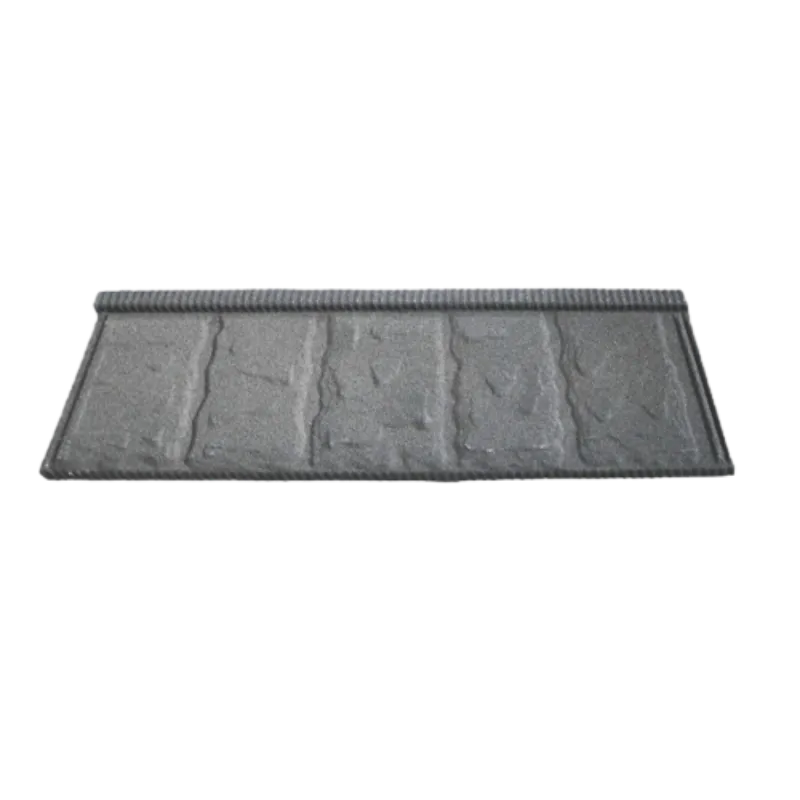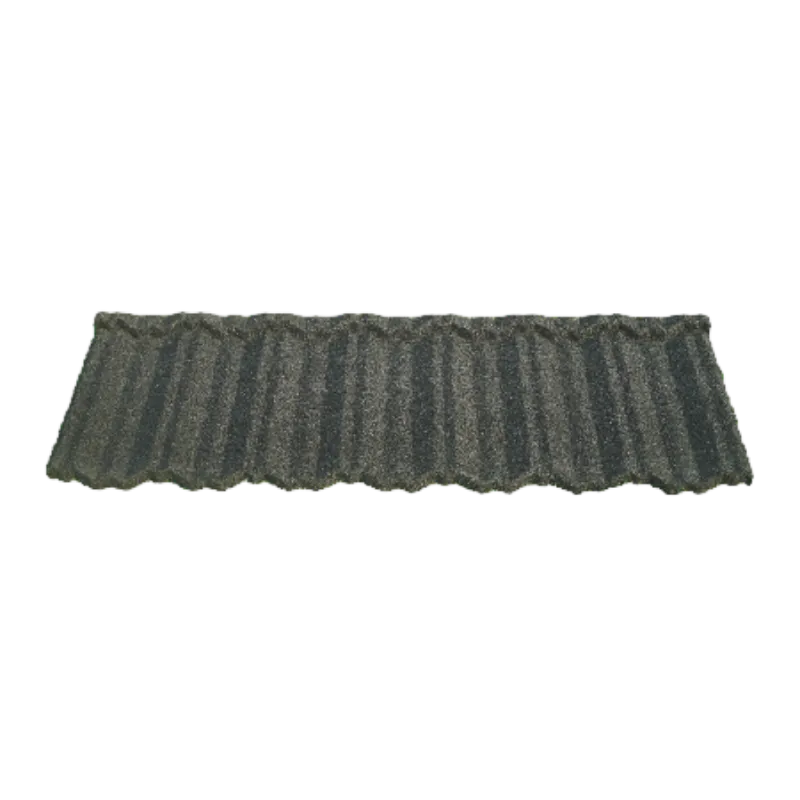
ആഗ . 22, 2025 12:32 പട്ടികയിലേക്ക് മടങ്ങുക
Roman Roof Tiles: Timeless Designs and Modern Variations
Roman Roof Tiles: Timeless Designs and Modern Variations
Ancient roman roof tiles stand as a testament to enduring architectural wisdom, with designs that have influenced roofing styles for millennia. Crafted originally from clay, these tiles featured interlocking shapes that provided exceptional protection against rain and wind, a quality that made them a staple in Roman architecture from humble dwellings to grand monuments. Their distinctive profile, characterized by curved and flat sections, allowed for efficient water runoff while adding a sense of symmetry to building exteriors. Even today, the essence of ancient roman roof tiles can be seen in modern adaptations, preserving both functionality and aesthetic appeal.
Black double roman roof tiles carry forward the classic design with a contemporary twist, offering a sleek, dramatic look that complements various architectural styles
Having two overlapping curves, the double Roman structure improves the efficiency of water flow, making it very suitable for areas susceptible to heavy rain. Its black surface not only gives an elegant feel, but also absorbs heat - a useful feature in colder climates as it helps maintain a more stable indoor temperature. These tiles typically replicate traditional clay textures while integrating modern materials to enhance their durability.
Bold double roman roof tiles make a striking statement with their pronounced curves and thicker profiles, designed to stand out in both residential and commercial settings
The boldness of their shape adds depth and dimensions on the roofs, creating visual interest, which enhances the overall design of the structure. In addition to aesthetics, their strong design ensures long life, increased resistance to impact from torment or pieces.This makes bold double roman roof tiles a popular choice for buildings where both style and resilience are priorities.
Bridgewater double roman roof tiles draw inspiration from regional architectural traditions, blending the double roman design with subtle variations that reflect local tastes
Drawing their monikers from unique regional influences—whether the sun-baked hues of Mediterranean villages, the rugged textures of Alpine valleys, or the earthy tones of coastal plains—these tiles often feature one-of-a-kind color palettes and subtly adjusted curves, each a deliberate homage to local architectural legacies. A tile inspired by Tuscany, for instance, might bear warm terracotta gradients and softer, more rounded edges, echoing the rustic charm of the region’s farmhouses, while one rooted in Greek island traditions could sport crisp white glazes and sharper contours, mirroring the stark, sunlit aesthetics of Cycladic buildings. Yet, beneath these regional flourishes, their interlocking design remains true to the Roman original: a system of overlapping ridges and grooves that creates an impenetrable barrier against rain, snow, and wind, ensuring reliable waterproofing performance even in harsh climates.
Brown double roman roof tiles offer a warm, earthy alternative that harmonizes with natural surroundings, making them a favorite for homes nestled in landscapes or rural areas. The brown hue, ranging from rich chestnut to soft terracotta, complements materials like stone or wood, creating a cohesive look. Like other double roman variants, they retain the interlocking design for weather resistance, with the added benefit of UV-resistant coatings in modern versions to prevent fading over time.
Clay double roman tiles stay true to the material roots of ancient roman roof tiles, using natural clay fired at high temperatures to achieve strength and durability
This classic material carries a distinct personality—each tile may have subtle differences in color and texture, which only add to the roof’s appeal. Clay’s inherent insulating qualities aid in regulating indoor temperatures, keeping spaces cooler during summer and warmer in winter. When shaped into the double Roman design, clay tiles merge age-old craftsmanship with functional performance.

In summary, ancient roman roof tiles have evolved into a diverse family of roofing solutions, including black double roman, bold double roman, bridgewater double roman roof tiles, brown double roman, and clay double roman variants. Each retains the core principles of the original design—interlocking shapes for weather resistance, distinctive profiles for aesthetic appeal—while adapting to modern needs and preferences. Whether through color, material, or subtle design tweaks, these tiles continue to offer a perfect blend of form and function, ensuring that the legacy of Roman roofing endures in contemporary architecture. Their ability to balance tradition with innovation makes them a timeless choice for any building seeking both protection and style.
Ancient Roman Roof Tiles FAQs
1. What materials were commonly used to make ancient roman roof tiles?
Ancient Roman roof tiles were mainly made from natural clay or terracotta, formed through molding and high-temperature firing. The most recognizable varieties—such as the flat tegula tiles and curved imbrex cover tiles—were crafted using locally available clay, which was fired at intense heat to enhance their strength. For more prestigious structures, some high-end tiles included marble or stone, adding to their grandeur. In areas like Pompeii, volcanic materials such as tuff were also occasionally employed, valued for their ability to withstand the elements.
2. How did ancient roman roof tiles contribute to architectural innovation?
The ancient Roman roofs turned Mediterranean architecture into a revolution. introduction of connecting systems to improve water safety. The combination of weights and imbrises created overlapping channels for efficient rainwater drainage, allowing for sharper roof heights. This design influenced later European roofing traditions and allowed the construction of excellent roofs. structures such as Pantheon, where the slabs are integrated with concrete technique.
3. What were the key functional advantages of ancient roman roof tiles?
Beyond their visual appeal, ancient Roman roof tiles delivered impressive thermal control, keeping indoor spaces cool during summer and well-insulated in winter. Their substantial weight provided resilience against powerful winds, while the fired clay composition offered resistance to decay and fire risks. Thanks to their standardized forms, mass production and maintenance were streamlined—some tiles even featured makers’ stamps as a means of quality oversight.
4. How did the design of ancient roman roof tiles reflect social status?
The size, finish, and material of ancient Roman roof tiles often served as indicators of a building’s significance. Elite villas and temples were adorned with finely polished tiles, some featuring red or glossy coatings to enhance their grandeur, while utilitarian structures such as workshops or storage facilities made do with rougher, unglazed versions. Imperial buildings, in particular, often bore tiles stamped with emperors’ names, a deliberate display of authority and legacy. Additionally, the use of imported clay—sourced from distant regions—or tiles decorated with intricate patterns further signaled wealth, power, and political influence, making the roof itself a visual statement of the building’s status within Roman society.
5. Why have ancient roman roof tiles survived for millennia in archaeological sites?
The intense, high-heat firing technique used in crafting ancient Roman roof tiles imbued them with a ceramic-like toughness, equipping them to fend off erosion and chemical deterioration over centuries. This remarkable durability is vividly evident in the many well-preserved tiles unearthed at archaeological sites such as Ostia, the ancient port of Rome, and Herculaneum, the city buried by Mount Vesuvius’ eruption—tiles that still retain their original shapes, their edges barely worn, and some even bearing faint traces of their initial paint, hints of the vibrant hues that once adorned them. Beyond their physical resilience, these tiles possessed a natural resistance to moisture and pests, traits that prevented rot, mold, or infestations from undermining their structure. As a result, examples of these tiles have survived across the vast territories of the former empire, from the heart of Italy to distant provinces, serving as tangible reminders of the engineering ingenuity and practical craftsmanship that defined Roman construction.
-
Architectural Asphalt Shingles: Integration of Practicality, Economy, And Aesthetics
വാർത്തAug.26,2025
-
The Importance of Bird Stop for Metal Roofing
വാർത്തAug.26,2025
-
Roofing Granule: Composition, Function, and Application
വാർത്തAug.26,2025
-
Granular Roll Roofing: Diverse Application Scenarios and Values
വാർത്തAug.26,2025
-
Asphalt Shingles: a Long-Lasting Roofing Material
വാർത്തAug.26,2025
-
Aluma Tile Metal Roofing: Excellent Performance and Aesthetic Value Coexist
വാർത്തAug.26,2025







